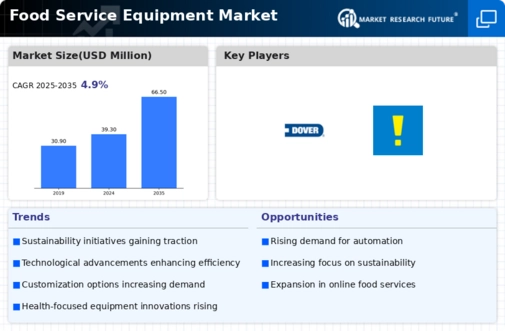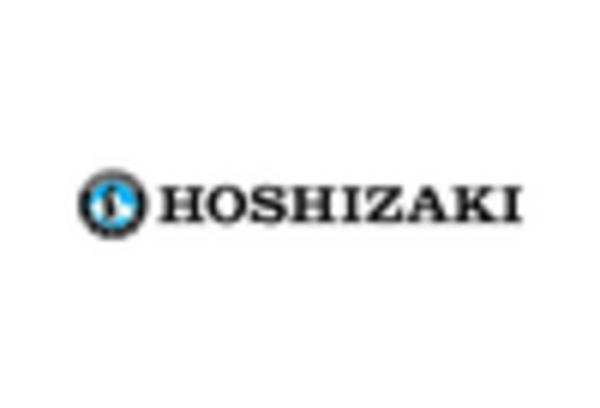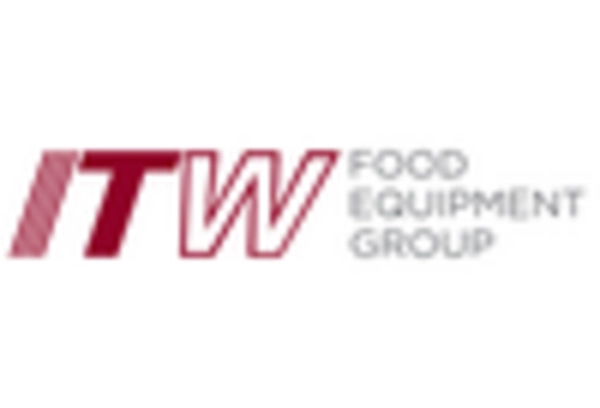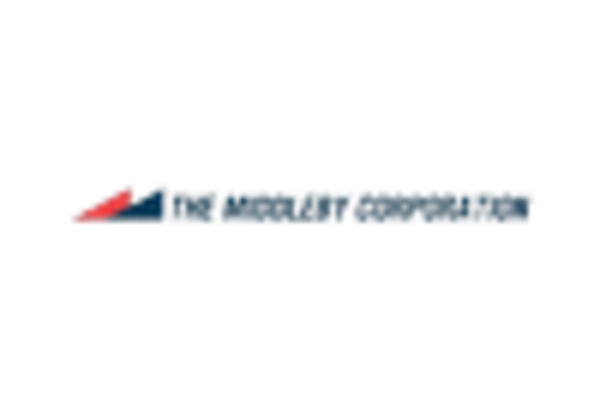-
Executive Summary
-
Scope of the Report
-
Market Definition
-
Scope of the Study
- Definition
- Research Objective
- Assumptions
- Limitations
-
Research Process
- Primary Research
- Secondary Research
-
Market Size Estimation
-
Forecast Sales Channel
-
Market Landscape
-
Porter’s Five Forces Analysis
- Threat of New Entrants
- Bargaining Power of Buyers
- Threat of Substitutes
- Rivalry
- Bargaining Power of Buyers
-
Value Chain/Supply Chain Analysis
-
Market Dynamics
-
Introduction
-
Market Drivers
-
Market Restraints
-
Market Opportunities
-
Market Trends
-
Global Food Service Equipment Market, by Product
-
Introduction
-
Cooking Equipment
- Market Estimates & Forecast, 2022-2030
- Market Estimates & Forecast, by Region, 2022-2030
-
Storage & Handling Equipment
- Market Estimates & Forecast, 2022-2030
- Market Estimates & Forecast, by Region, 2022-2030
-
Ware Washing Equipment
- Market Estimates & Forecast, 2022-2030
- Market Estimates & Forecast, by Region, 2022-2030
-
Food Holding & Serving Equipment
- Market Estimates & Forecast, 2022-2030
- Market Estimates & Forecast, by Region, 2022-2030
-
Others
- Market Estimates & Forecast, 2022-2030
- Market Estimates & Forecast, by Region, 2022-2030
-
Global Food Service Equipment Market, by Application
-
Introduction
-
Full-Service Restaurants
- Market Estimates & Forecast, 2022-2030
- Market Estimates & Forecast, by Region, 2022-2030
-
Quick Service Restaurants
- Market Estimates & Forecast, 2022-2030
- Market Estimates & Forecast, by Region, 2022-2030
-
Caterers
- Market Estimates & Forecast, 2022-2030
- Market Estimates & Forecast, by Region, 2022-2030
-
Hotels & Clubs
- Market Estimates & Forecast, 2022-2030
- Market Estimates & Forecast, by Region, 2022-2030
-
Others
- Market Estimates & Forecast, 2022-2030
- Market Estimates & Forecast, by Region, 2022-2030
-
Global Food Service Equipment Market, by Region
-
Introduction
-
North America
- Market Estimates & Forecast, by Country, 2022-2030
- Market Estimates & Forecast, by Product, 2022-2030
- Market Estimates & Forecast, by Application, 2022-2030
- US
- Canada
-
Europe
- Market Estimates & Forecast, by Country, 2022-2030
- Market Estimates & Forecast, by Product, 2022-2030
- Market Estimates & Forecast, by Application, 2022-2030
- UK
- Germany
- France
- Italy
- Rest of Europe
-
Asia-Pacific
- Market Estimates & Forecast, by Country, 2022-2030
- Market Estimates & Forecast, by Product, 2022-2030
- Market Estimates & Forecast, by Application, 2022-2030
- China
- Japan
- India
- Rest of Asia-Pacific
-
RoW
- Market Estimates & Forecast, by Region, 2022-2030
- Market Estimates & Forecast, by Product, 2022-2030
- Market Estimates & Forecast, by Application, 2022-2030
- Middle East and Africa
- South America
-
Competitive Landscape
-
Company Profiles
-
Meiko
- Company Overview
- Products/Services Offered
- Financial Overview
- Key Developments
- Key Strategies
- SWOT Analysis
-
Hobart Corporation
- Company Overview
- Products/Services Offered
- Financial Overview
- Key Developments
- Key Strategies
- SWOT Analysis
-
Ali Group S.p.A
- Company Overview
- Products/Services Offered
- Financial Overview
- Key Developments
- Key Strategies
- SWOT Analysis
-
Fujimak Corporation
- Company Overview
- Products/Services Offered
- Financial Overview
- Key Developments
- Key Strategies
- SWOT Analysis
-
Manitowoc Company Inc.
- Company Overview
- Products/Services Offered
- Financial Overview
- Key Developments
- Key Strategies
- SWOT Analysis
-
Hoshizaki Electric Co., Ltd.
- Company Overview
- Products/Services Offered
- Financial Overview
- Key Developments
- Key Strategies
- SWOT Analysis
-
Dover Corporation
- Company Overview
- Products/Services Offered
- Financial Overview
- Key Developments
- Key Strategies
- SWOT Analysis
-
Duke Manufacturing Co. Inc.
- Company Overview
- Products/Services Offered
- Financial Overview
- Key Developments
- Key Strategies
- SWOT Analysis
-
Tupperware Brands Corporation
- Company Overview
- Products/Services Offered
- Financial Overview
- Key Developments
- Key Strategies
- SWOT Analysis
-
Electrolux AB
- Company Overview
- Products/Services Offered
- Financial Overview
- Key Developments
- Key Strategies
- SWOT Analysis
-
List of Tables
-
Global Food Service Equipment Market, by Region, 2022-2030
-
North America: Food Service Equipment Market, by Country, 2022-2030
-
Europe: Food Service Equipment Market, by Country, 2022-2030
-
Asia-Pacific: Food Service Equipment Market, by Country, 2022-2030
-
RoW: Food Service Equipment Market, by Region, 2022-2030
-
Global Food Service Equipment Market, by Product, by Regions, 2022-2030
-
North America: Food Service Equipment Market, by Product, by Country, 2022-2030
-
Europe: Food Service Equipment Market, by Product, by Country, 2022-2030
-
Asia-Pacific: Food Service Equipment Market, by Product, by Country, 2022-2030
-
RoW: Food Service Equipment Market, by Product, by Region, 2022-2030
-
Global Food Service Equipment Market, by Application, by Regions, 2022-2030
-
North America: Food Service Equipment Market, by Application, by Country, 2022-2030
-
Europe: Food Service Equipment Market, by Application, by Country, 2022-2030
-
Asia-Pacific: Food Service Equipment Market, by Application, by Country, 2022-2030
-
RoW: Food Service Equipment Market, by Application, by Region, 2022-2030
-
Global Food Service Equipment Market, by Product, 2022-2030
-
Global Food Service Equipment Market, by Application, 2022-2030
-
North America: Food Service Equipment Market, by Product, 2022-2030
-
North America: Food Service Equipment Market, by Application, 2022-2030
-
Europe: Food Service Equipment Market, by Product, 2022-2030
-
Europe: Food Service Equipment Market, by Application, 2022-2030
-
Asia-Pacific: Food Service Equipment Market, by Product, 2022-2030
-
Asia-Pacific: Food Service Equipment Market, by Application, 2022-2030
-
RoW: Food Service Equipment Market, by Product, 2022-2030
-
RoW: Food Service Equipment Market, by Application, 2022-2030
-
-
List of Figures
-
Research Process of MRFR
-
Top-Down and Bottom-Up Approach
-
Market Dynamics
-
Impact Analysis: Market Drivers
-
Impact Analysis: Market Restraints
-
Porter''s Five Forces Analysis
-
Value Chain Analysis
-
Global Food Service Equipment Market Share, by Product, 2020 (%)
-
Global Food Service Equipment Market, by Product, 2022-2030 (USD MILLION)
-
Global Food Service Equipment Market Share, by Application, 2020 (%)
-
Global Food Service Equipment Market, by Application, 2022-2030 (USD MILLION)
-
Global Food Service Equipment Market Share (%), by Region, 2020
-
Global Food Service Equipment Market, by Region, 2022-2030 (USD MILLION)
-
North America: Food Service Equipment Market Share (%), 2020
-
North America: Food Service Equipment Market, by Country, 2022-2030 (USD MILLION)
-
Europe: Food Service Equipment Market Share (%), 2020
-
Europe: Food Service Equipment Market, by Country, 2022-2030 (USD MILLION)
-
Asia-Pacific: Food Service Equipment Market Share (%), 2020
-
Asia-Pacific: Food Service Equipment Market, by Country, 2022-2030 (USD MILLION)
-
RoW: Food Service Equipment Market Share (%), 2020
-
RoW: Food Service Equipment Market, by Region, 2022-2030 (USD MILLION)

















Leave a Comment